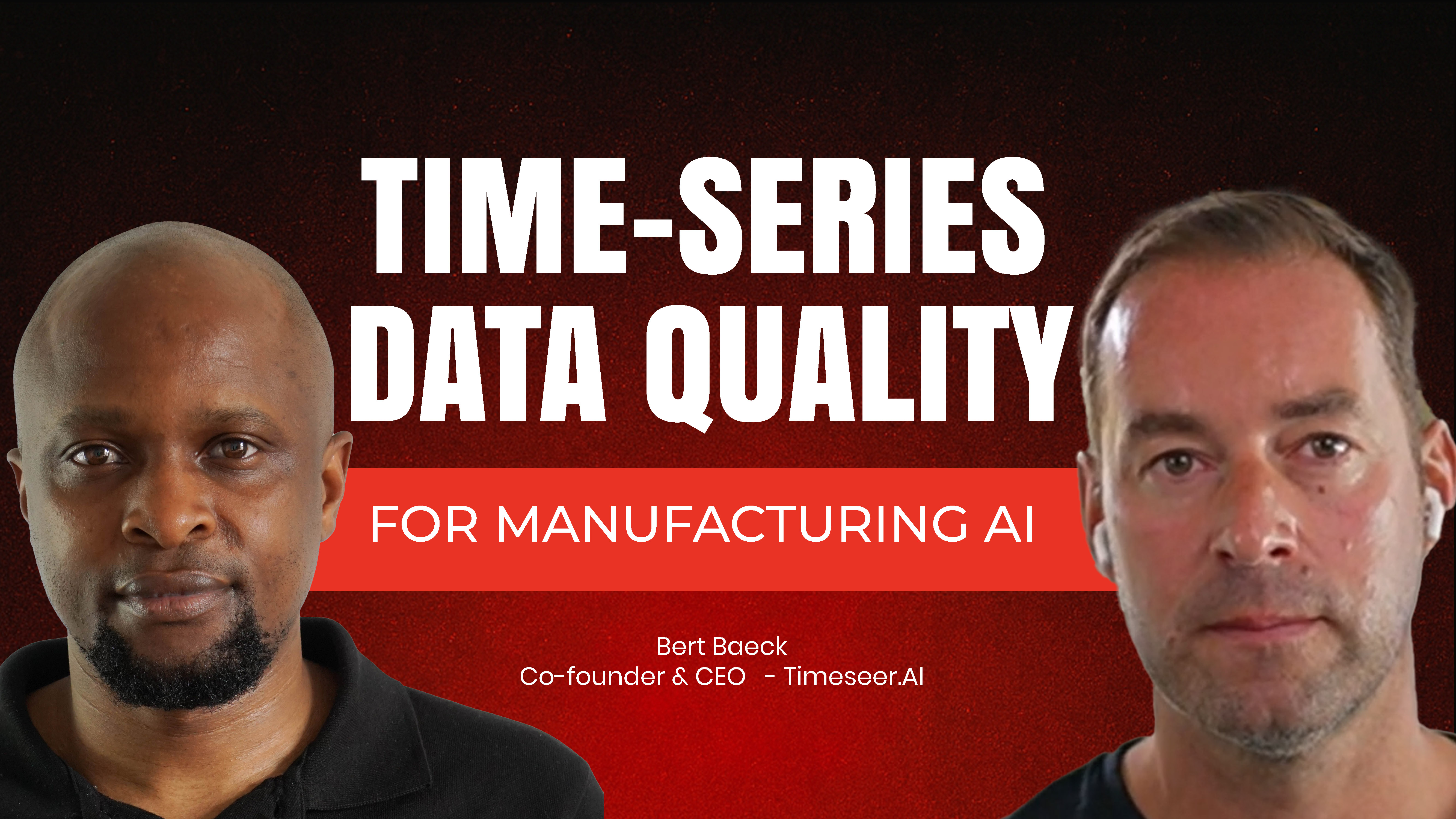November 2, 2025

Your plant is running normally. All sensors show green. Data flows into your historian at the expected rate. The schema hasn't changed. From an IT perspective, everything is perfect.
But that temperature sensor on Line 3? It's been flatlined at 187°F for the past six hours, well within normal range, so no alarms triggered. The sensor is actually broken. Your control logic, relying on that static reading, just made a series of cascading bad decisions that will trip your compressor in two hours, causing production downtime that costs six figures.
This is data downtime. Your plant looks fine, but the data underlying it is lying.
Bert Berg, co-founder and CEO of Timescale.ai, spent 10 years at Bayer working with industrial sensor data before founding TrendMiner (acquired by Software AG in 2018). He's seen this pattern destroy AI projects repeatedly: not because of bad models, but because nobody caught the lying data early enough.
The uncomfortable truth he's learned: 95% of manufacturing companies store sensor data but have no clear owner for its quality. They encourage teams to build dashboards and AI models on that data while having no idea if it's trustworthy. That's not a data asset. That's a liability waiting to detonate.
The $1 to $100 Cost Escalation
Data downtime has a predictable cost curve that most manufacturers don't recognize until it's too late. Understanding this escalation is critical for justifying investment in data quality infrastructure.
$1: Detection at the source
Monitoring data quality where it's generated costs roughly $1 per issue detected. Automated checks catch sensor calibration problems, unexpected gaps, drifts, or flatlines before that data enters your analytics pipeline. It's pure prevention.
$10-$20: Reactive correction
If you don't catch issues at the source, someone discovers them later—in a dashboard, during analysis, in a compliance report, or worse, in a billing flow. Now a data engineer or analyst spends hours manually correcting the problem, tracking down root causes, and fixing downstream impacts. The cost just jumped 10-20x.
$100: Operational impact
The sensor that's been flatining? It feeds your control logic. That drift in your flow meter? It's causing your process to run suboptimally for weeks. The gap in quality data? It masked a degradation pattern that just became a failure. When data quality problems cause operational issues, downtime, safety incidents, quality excursions, lost production—costs explode to 100x the monitoring cost.
A real example: A manufacturing client had a flatlining sensor that looked normal (within spec range). Because no one was monitoring for this specific data quality issue, the faulty reading fed into control logic and eventually tripped a compressor. Production downtime. Six figures in losses. All preventable with $1 worth of monitoring.
This cost curve should fundamentally change how you think about data quality investment. It's not a "nice to have" analytics feature. It's operational risk management.
Why Time Series Data Breaks Traditional Data Quality Tools
Your IT team has data quality tools. They check if data is fresh, if schemas haven't changed, if tables are complete. For relational data, those tools work fine.
For sensor data, they're completely inadequate. Here's why:
Traditional IT data quality checks:
- Is data arriving at expected rates? ✓
- Is the schema correct? ✓
- Are there null values? ✓
- Conclusion: Data looks perfect
What's actually happening with your sensor data:
- Subtle drift indicating sensor degradation
- Oscillations suggesting valve problems
- Flatlines within normal range (broken sensor)
- Impossible jumps between readings
- Correlations breaking down between related sensors
- None of this triggers traditional data quality alerts
The fundamental problem: relational data quality tools check tables. Sensor data requires understanding physics. A flow measurement behaves differently than a pressure reading, which behaves differently than temperature. Traditional tools can't judge whether sensor behavior is physically plausible—they only know if data is present and formatted correctly.
The ownership dilemma this creates:
When sensor data quality problems are detected, whose problem is it? A broken sensor isn't a data problem—it's an operational problem. Someone needs to physically repair or replace hardware. Traditional IT data quality teams can't make that call. They don't understand the operational context to judge if a sensor reading is trustworthy.
This is why sensor data quality falls between the cracks. IT can't judge reliability. Operations doesn't think they have a data quality problem (their real-time control systems work fine). Meanwhile, data scientists and analysts waste weeks on bad data, and AI models fail in production because nobody validated the input stream.
The Trust Layer - Where Data Quality Actually Belongs
Most companies approach data quality as a feature within analytics tools. Every dashboard, every AI platform, every ML environment handles data quality slightly differently. This creates chaos—no single version of truth, no consistent quality standards, duplicated effort everywhere.
The solution is architectural: data quality needs to shift left, becoming a distinct layer in your stack.
The new architecture:
Storage layer → Trust layer → Consumption layer
- Storage: Industrial historians (OSIsoft PI, others), cloud data warehouses (Databricks, Snowflake, Azure), time series databases
- Trust layer: Centralized data quality validation, monitoring, and cleansing before consumption
- Consumption: Dashboards (Power BI), analytics (TrendMiner, Seeq), ML platforms, SAP integration, billing systems
The trust layer provides a service level agreement to all downstream consumers: data passing through here has been validated for reliability. Every application can assume quality has been checked centrally rather than building separate validation into each tool.
Why this matters strategically:
Scanning data where it's generated, at the historian or sensor level, catches problems before they propagate. If you wait until data reaches the cloud or a data warehouse, the damage is already done. Data that never gets used for analytics might still contain critical operational signals (that flatlining sensor indicating failure), and you miss those insights if you only check data you're actively analyzing.
Think of it like antivirus software: you scan for threats where they arise, not after they've already infected your entire system. Data quality works the same way.
The Four Components of Data Quality at Scale
Building effective data quality infrastructure for sensor data requires four distinct capabilities working together:
Component 1: Scoring (Quality Assurance)
Profile all your sensor data to establish a baseline. Check 100-200 different types of issues that can occur with time series data: outliers, impossible jumps, gaps, null values, drifts, anomalies, broken correlations, oscillations. For each sensor, assess: is this data reliable? What problems exist? This gives you the heat map showing where quality issues concentrate across your operations.
This is static analysis—typically run against historical data (past year) to understand your starting point. Most companies discover they're operating with 50-80% data reliability, not the 95%+ they assumed.
Component 2: Monitoring (Continuous Quality Assurance)
Move from static baseline to dynamic, continuous monitoring. Check data quality every minute, hour, or day depending on use case requirements. If you're running real-time AI models, you need minute-by-minute validation. For weekly reporting, daily checks suffice.
This catches new issues as they emerge—sensors drifting, new calibration problems, infrastructure failures—before they impact operations or analytics.
Component 3: Cleaning and Validation
When quality issues are flagged, some can be automatically corrected (remove outliers, interpolate short gaps using algorithms). But longer gaps or complex issues require human judgment. Data stewards or analysts need interactive workflows to review flagged data, make correction decisions, and validate repairs.
Example: A utility billing water consumption discovered metering errors through quality monitoring. Automated cleaning handles simple issues, but gaps longer than 24 hours require manual review to determine appropriate corrections before billing customers.
Component 4: Uniformization (Service Level Agreements)
Define quality requirements for specific data products: "This dashboard requires 99.9% fresh data with no gaps or drifts." Monitor continuously against those SLAs, flagging when data doesn't meet standards before it reaches users. This guarantees downstream consumers that data meets defined quality thresholds.
These four components work as a system, not standalone features. The baseline (scoring) informs what to monitor, monitoring catches issues early, cleaning repairs what's fixable, and SLAs protect downstream consumption.
The Ownership Question Nobody Wants to Answer
Here's the uncomfortable finding from surveying 200+ manufacturing organizations: it's unclear who owns sensor data quality at most companies.
The problem:
Operations owns the sensors and processes generating the data. IT owns data infrastructure and governance. Data science teams consume the data for analytics. Nobody definitively owns validating whether sensor data is trustworthy.
Operations doesn't see a data quality problem—their real-time control systems work, alarms function, production runs. For their immediate needs, data quality is "good enough" because humans are in the loop catching obvious issues.
IT can check technical metrics (data freshness, schema validity) but can't judge whether a sensor reading is physically plausible or operationally meaningful.
Data teams discover quality problems only after investing significant time in analysis, but they lack authority to fix root causes (broken sensors, calibration issues, infrastructure problems).
Why this matters more now:
Companies are encouraging digital transformation—pushing teams to build more dashboards, more AI models, more data-driven decision making. But they're scaling consumption of data without scaling quality assurance. That's a recipe for scaling failure, not success.
If you're telling people to make decisions based on data while nobody owns validating that data's reliability, you're creating liability, not value. Every dashboard built on unvalidated data, every AI model trained on unchecked sensor streams, every billing system relying on sensor readings—these are all risks compounding.
The answer:
Data quality for sensor data should be owned by operations or by someone who can judge operational context and sensor reliability. It can't live purely in IT because the required domain knowledge is operational, not technical. But it needs governance framework, tooling, and clear accountability that most organizations haven't established.
Conclusion
Most AI project failures aren't model failures. They're data failures. The pattern is consistent: teams build sophisticated models, achieve great accuracy in testing, then fail in production because the input data stream was unreliable from day one.
The $1 to $100 cost escalation isn't hypothetical—it's the difference between proactive monitoring and reactive damage control. Every week you delay implementing systematic data quality validation, you accumulate technical debt that gets exponentially more expensive to fix.
The manufacturers winning with AI aren't building better models than their competitors. They're building on better data. They've established the trust layer, shifted quality checks to the source, and assigned clear ownership for sensor data reliability.
Your competitors are probably still treating data quality as an afterthought, scattered across analytics tools as separate features. That's your window of opportunity. Build the trust layer now, establish systematic quality validation, and you'll be deploying AI that actually works while others are still debugging why their models fail in production.
The question isn't whether to invest in data quality infrastructure. It's whether you can afford not to—when every AI initiative, every operational decision, and every data-driven insight depends on data you can't currently vouch for.
Start with the baseline. Score your current data quality across all sensors. Most companies discover they're at 50-80% reliability. That's your business case. Then build from there: monitoring, cleaning workflows, and SLAs that guarantee quality before consumption.
Because data that looks fine but is lying isn't an asset. It's a liability waiting to cost you 100x what prevention would have cost.
Kudzai Manditereza is an Industry4.0 technology evangelist and creator of Industry40.tv, an independent media and education platform focused on industrial data and AI for smart manufacturing. He specializes in Industrial AI, IIoT, Unified Namespace, Digital Twins, and Industrial DataOps, helping digital manufacturing leaders implement and scale AI initiatives.
Kudzai hosts the AI in Manufacturing podcast and writes the Smart Factory Playbook newsletter, where he shares practical guidance on building the data backbone that makes industrial AI work in real-world manufacturing environments. He currently serves as Senior Industry Solutions Advocate at HiveMQ.



